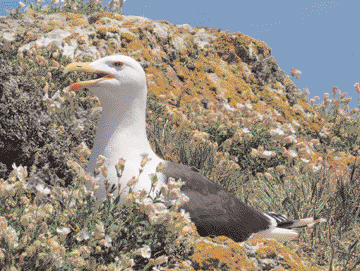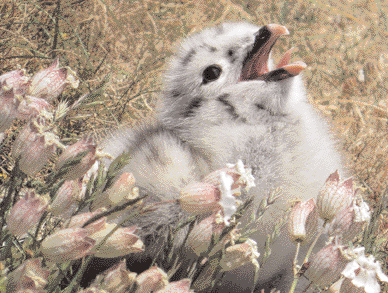|
Wildlife
Newsletter for the Township of Dalkey July 2013 - Michael Ryan |
| I
was able to brake in time as a fox darted across the road in front of
the car but thought a moment later that if I had hit it and killed it
instantly I might have done it a favour. It looked emaciated but that
was because it had barely any fur and what it had was patchy with bare
spots. It’s tail instead of being a luxuriant brush was totally
bald and stuck out behind it like a piece of wire. I certainly couldn’t
say for sure what was wrong but it almost certainly had mange. Sarcoptic
Mange is caused by a mite which infects the skin causing terrible irritation
to the animal. Foxes have been known to gnaw off their own tails to
try and alleviate the itching and sometimes foxes will die from secondary
infections since the constant scratching prevents the broken skin from
healing and they will contract other infections. I’d heard of
quite a number of foxes infected with it around Dalkey and when I spoke
to my vet’s practice which is based in Blackrock they said they’d
also had a unusually high number of inquiries about infected foxes this
year. |
 Greater
Black Backed Gull Greater
Black Backed Gull |
 Greater
Black Backed Gull’s chick. Greater
Black Backed Gull’s chick. |
Unfortunately
there’s very little that can be done for individual animals and
the vet says even if an animal was taken in and treated it would be
as likely as ever to contract the disease again when it was released
back into the wild. Afew of us went out to Ireland’s Eye during
the very hot spell in June to see the seabird colonies that nest on
the cliffs. We usually leave our annual visit till July when chicks
are born or the birds will be sitting on eggs. It was still a bit early
for the razorbills, guillemots, 5 kittiwakes and gannets to have chicks
but some members of one breeding species of bird out there already had
hatched chicks or had eggs about to open. This was the Greater Black
Backed Gull which instead of clinging to perilously narrow edges of
the cliff face nests in the open on the ground on the higher areas of
the island. The parent birds can get very agitated when someone walks
near the nest and they are quite formidable creatures (the largest species
of gull in the world) especially when they are ill disposed towards
you. |
|
We
had been warned before we went out by a friend, who had recently been
on the island, about a few ‘psycho’ greater black backed
gulls which were nesting near the highest point of the island and were
particularly aggressive. This part of the island is close to the great
tower of rock known as the Stack which is home to a colony of hundreds
of gannets and is always worth a look, worth risking an angry gull attack.
We were treated to the sight of a peregrine perched on top of the rock
as we ate our packed lunches in the blazing sunshine. A greater black
backed gull was perched quite near us and a tiny fluffy grey chick appeared
from the undergrowth. The
parent bird was calling raucously but it didn’t come near us maybe
figuring if were predators we’d have tried to eat the chick by
now rather then tucking in to cheese sandwiches. Wemoved to the summit
to view the gannets where another visitor to the island was sitting
sketching birds. He’d already had a close encounter with a gull
which had flown down and hit him on the head and although he was wearing
a hat the impact of the birds beak had drawn blood. The rest of my companions
had moved off when I felt a whoosh of wings passing inches over my head
as a greater black backed gull wheeled around and came in for another
attack, a determined look in its eyes. |
||
|
Carrying a telescope around an island can be a bit awkward
but it’s great for getting good close up views of nesting birds
and, as in this case, it serves as an efficient air attack defence when
held aloft. Gannets are another large and very impressive seabird with
their beautiful blue eyes and snow white plumage with black tipped wings
but the bird everybody loves to see is the smallest sea bird breeding
there. We’d earlier been scanning the northern facing cliffs with
a telescope set up facing the packed colonies of birds on the cliffs.
A chap was filming them with a small video camera and I offered him
a look through the ‘scope. As
soon as he looked through it he instantly became very animated since
it was trained on a little group of puffins. He said he didn’t
even know you got them in this country let alone a few miles away from
the city centre. His reaction to first seeing them is typical of anyone
who sees a puffin for the first time.
|
|
With their almost comical appearance they’re very charming little
creatures. A small colony nests in burrows on very steep slopes on the
side of the island. Although there are far greater numbers of puffins
a few miles north on Lambay Island the Ireland’s Eye colony has
survived and possibly grown slightly in the last few years. There’s
still time to visit and see the birds on Ireland’s Eye though
peak time for seeing chicks on nests would be the first few weeks in
July. A number of small ferry boats go out from Howth Harbour though
it would be worth checking first online to see if they’re going
out as strong seas can sometimes make landing difficult. Crossing the
island involves a deal of climbing and walking paths through shoulder
high ferns with rabbit holes underfoot. We called down to Coliemore
Harbour early the following day, Sunday, which was to be the last day
of the intense heat before the weather returned to the more typical,
rain every day seasonal climate. I was relieved to see the Arctic terns
were still sitting on nests at the summit of Lamb Island. Although late
to arrive they had quickly established themselves with at least 40 nests
visible from the land. I was afraid that during the hot spell somebody
might have climbed up there and disturbed them which is almost certainly
what happened last year when the whole colony disappeared one weekend
with the almost certain loss of many chicks and unfledged birds. Unfortunately
when I went down two days later there wasn’t a single bird on
the island. My pessimism had been well founded, somebody had probably
gone on to Lamb Island or else the goats had been frightened off the
main island, crossed over at low tide and either trampled the nests
or frightened off the birds. Lots of eggs would have been lost and possibly
even some chicks since the birds had been there long enough for eggs
to have hatched. They might try and nest again but at time of writing
there was no sign of any birds returning and it might be better in the
long run if they moved away from Dalkey to somewhere safer to nest.
|